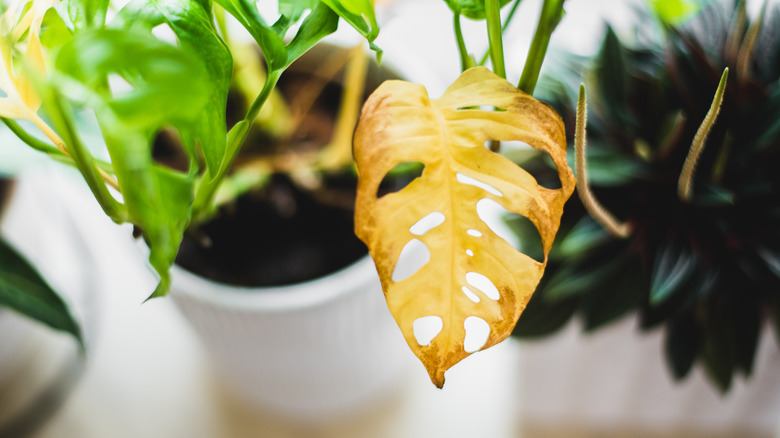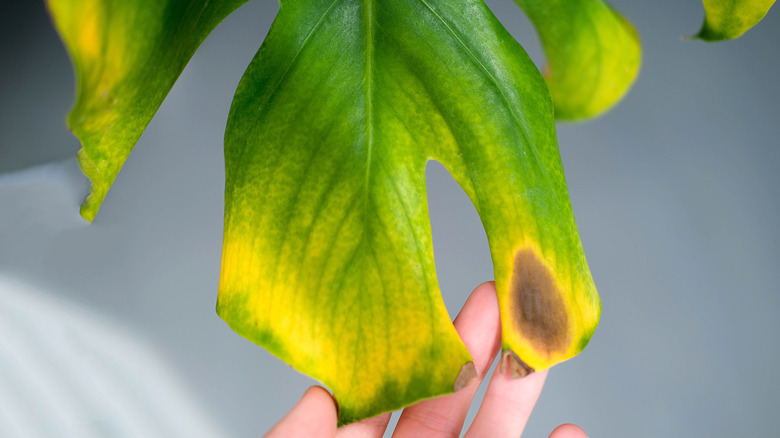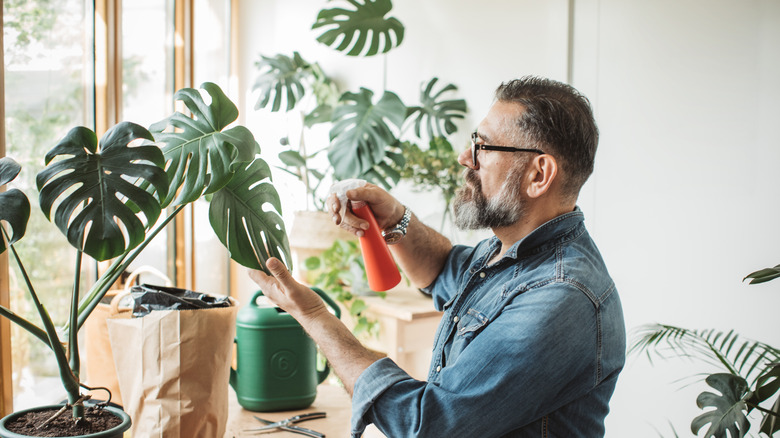The Real Reason The Leaves On Your Swiss Cheese Plant Are Turning Yellow
The Swiss cheese plant (Monstera Deliciousa), also known as the monstera, is a common house plant that serves as a great way to bring a warm, tropical feel into your home. These giant-leafed beauties are easy to care for and are even considered a great option for new plant parents hoping to start their own vegetative family. However, regardless of expertise, many monstera owners struggle to keep the plant's leaves from yellowing.
Like any other plant, monsteras come with their own detriments, which stem from particular desires they need fulfilled in order to thrive. Yellow leaves are concerning for these plants because of how many variables can cause them. Unbalanced watering, too much light, pests, incorrect humidity levels, and improper potting conditions can all lead to yellowing. Fortunately, as soon as you find and correct the reason for your monstera's sad condition, the hardy plant will bounce back to its gorgeous, healthy green in no time.
Identifying the root of the problem
The monstera is easily identifiable because of its giant shiny leaves covered in scattered holes of all shapes and sizes. They have such a distinct look and stunning green saturation when healthy. That being said, muted yellow spots are tell-tale signs of an unhappy plant. Fortunately, because it is such a sustainable houseplant, it is typically easy to get to and correct the root of the problem. First and foremost, examine your plant and the spots that are concerning. Oftentimes, where yellowing occurs says a lot about why it began in the first place.
An improper amount of light, such as direct and harsh sunlight, often causes yellowing along the veins of the leaf and in patches, while yellow hues on the tips of monstera leaves point to a lack of nutrients in the soil. Leaves can also become brittle and yellow if the plant has not been watered enough or has an insufficient amount of humidity and can also appear to rot when it receives too much moisture.
Correcting the issue
Once you feel that you have confidently diagnosed your monstera with one of the common causes for yellowing, it's time to address and correct the problem. Some issues are typically easy, one-time fixes. If you find that your monstera has overgrown its current home, replant it in a larger pot of nutrient-rich soil to give its roots more room to grow. Be sure that your soil includes nitrogen, phosphorus, and potassium, the three macronutrients that keep a plant happy and healthy. Improper lighting conditions, both too little and too much, are also easy to fix. Simply move your monstera to a part of your home that gets a balanced amount of sunlight, as these plants thrive in soft, moderate lighting.
Other reasons for yellowing, like imbalanced watering, improper humidity levels, and pest invasions, take a bit more time to correct. If your monstera's leaves are discolored because of watering issues, identify if you are watering too often or too scarcely and adjust accordingly. Monstera plants should be watered once a week or once every two weeks to the point of full soil saturation. And, for plants suffering from a lack of humidity, daily misting from a spray bottle should do the trick. This, along with many other natural pest deterrents like cayenne pepper and other spices, is also a great way to keep bugs away and regain control of your monstera's health.


